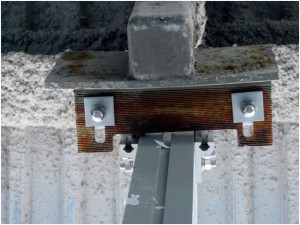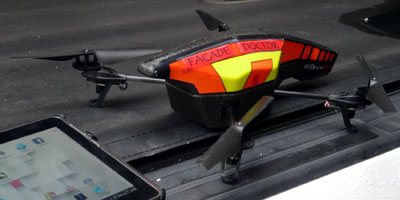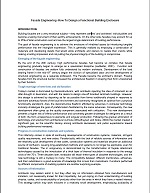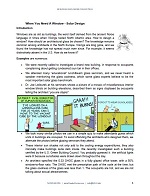Tools of the Trade – Photographic Equipment

Picture is worth a thousand words: a curtain wall anchor with twisted serrated washers. (Twisted washers don’t offer sufficient wind resistance).
Picture is worth a thousand words. A good picture can also save a lot of nerves. A good photo of a construction defect or a facade failure is self-explanatory and often cuts unnecessary disputes before they even start. This is why I consider a camera to be my primary tool of the trade.
Apparently, the photos illustrating my field reports stand out on their own, because one of the most often asked question I hear is “how did you take this photo?”
Several clients asked my advice on buying the photographic equipment, and I thought is would be good to share pro publico bono the one I gave recently. Here it is, below.
ULTRAZOOMS.
I only use ultrazooms because I typically take pictures of distant façade details. Here are some ultrazoom reviews: enough reading for a whole weekend from D Preview: Here is the youngest descendant of my Panasonic camera, Nikon , Sony , and Canon.
There is no rule of thumb in the choice. Each model of each product comes with its pros and cons. I owned Olympus, Sony, Panasonic, etc: (ultrazooms only because of my profession). I.e. one Sony I used for 2+ years was great, and then I purchased a younger (and supposedly better) model, I sadly discovered that it missed the most important functions I needed. Some cons can be easily offset. I.e. short battery life is taken care of by purchasing extra large amperage battery, a bad built-in mic is easy to offset by purchasing a good add-on microphone, etc.
BASIC THOUGHTS
- Quality of the photo is what matters, and it typically depends on one chief aspect: the brightness of the lens. This is why pictures taken with cell phones, tablets, and small cameras look so ugly. Get the best money can buy.
- Image stabilization is a must. Most modern equipment has some. Get the best money can buy.
- The number of megapixels does not matter (unless you plan to print posters later). Pay no attention to this number. In most cases email recipients appreciate much lower resolution for obvious reasons. Streamline downsizing choices seldom offer good quality (i.e. free MIR software). I found Photoshop is the only choice, but it’s time consuming.
- Objects move, and therefore one typically needs a fast shutter and as little shutter lag as possible. I.e. for years consumer-level Nikons were the only cameras which allowed to take reliable pictures of cats (cats move very fast, but we can seldom see it until we take their photo). I don’t know if Nikon still holds this distinction; however the fast shutter is only affordable with bright settings, which means: 1) good illumination and 2) bright lens. Otherwise photo would be shaky and unsable.
- One important thing to consider is when you move North (i.e. Canada or Poland), the average sky illumination is half of the South (ask me how I know – I run architectural daylight simulations), so you would need a very bright lens, and a powerful shake compensation in order to be able to make good pictures. A good extra flash would help in many situations too. Every time I take pictures in the North, I later discover most of my photos to be shaky, because it also requires changes in shooting habbits.
- Another thing to consider is the still pictures no longer cut it in many situations. One video is worth a thousand pictures. Video camcorders of good quality became gradually affordable and they allow for filming in darkness (which is the most commonly encountered illumination level); however, in order to make the resulting product digestible, they need to be heavily processed (99% of the video is rubbish). Cutting and development of video files requires extra labor and knowledge, and the acceptable software (i.e. Sony Vegas or Adobe Premiere) and a fast computer (i.e. SSD hard drive) add to the cost.
- Almost all modern good cameras allow for some video filming; however, with some severe limitations. However, many modern video cameras allow for taking still pictures of acceptable quality because they have large lenses.
- Most building interiors require very wide angle lens (almost fish eye) because space is tight. I.e. the GoPro I use has 127 degrees wide lens, and it seems to be an acceptable limit.
- A strap-on video camcorder (like the GoPro I use) is also great for a full-time recording, in lieu of hundreds general progress photos, in which one can easily get lost later. Example: once I had only one day for the leak and mold-mildew investigation on a remote site: a complex hospital campus consisting of several buildings, built organically without a plan for decades. What was supposed to be a single leak location, turned out to be over ten separate leaks, to which I was hastily escorted through a labyrinth of corridors, elevators, terraces, and roof ladders. The chief engineer who invited me there, didn’t have any plans or elevations, (which I always ask for earlier, so I can trace the location on site). If I didn’t take a video, I would be completely lost in my analysis and description later.
TRICKS OF THE TRADE
I use some pre-set settings because I typically: 1) cannot miss a photo, and 2) take pictures against something bright (a drop of water on a window frame shot against a bright sky and sun shining outside during water testing of a fenestration is a good example). Therefore, I use bracketing at several exposure settings, so every time I press a shutter, the camera takes three pictures, differing in exposure. This way I hope I would be able later to pick the acceptable one. I also preset the low-light exposure, by locking the settings on something dark at the same distance, (by pressing shutter half way and moving on the target before taking a picture). Target is not the only thing that moves. Diminish the camera movement by pressing against something stable, i.e. a post, column, or tabletop.
VULNERABILITIES
You probably have noticed I don’t treat my equipment very kindly. I pack all cameras, extra batteries, memory cards, mic, cables and chargers in bubble envelopes and than throw them in one generic shopping bag. This way it fits better in my carryon bag. I discovered they are generally very durable, except for three aspects: 1) they hate water (this water testing spray disables them for at least one day), and 2) the unprotected lenses (i.e. GoPro housing) are prone to scratches, 3) a cable sheathing quickly breaks, exposing wires.
STUFF
- I carry an ordinary $2 microfiber cloth to clean lenses. I keep it in the same wrap, and it magically takes care of the dust inherent in construction sites.
- Most modern cameras and camcorders come with some sort of image stabilization, which seldom suffices but is a significant improvement over the old equipment.
- I also own several tripods. For still photography, one only needs the elementary stability and height (don’t buy short ones) and these cost less than $30. For video though, the specifications and price skyrockets, but there are some exceptions if one researches well. Video may also require steadycam gizmos, which often cost more than a camcorder. They look deceptively simple, but there is a long learning curve to build one from the scratch. I own a large tool shop, so I attempted to build one myself, and even made a video illustrating the process, which I had never the time to finish and post online. Anyway, the lesson learned was: it would be better to buy one.
- Years ago I used a small bag filled with some light granules, which was sold as a wrist support for computer mouse operators. It stabilized a camera like a sand bag, but was lighter. Place it on a table, craddle the camera in it, and use the 2 sec. shutter delay to get a stable photo.
BUYING
Warning: some of online sites won’t even allow you to browse from a non-US location. However, Americans enjoy the very best prices and purchase terms in the world.
Once you determine which item you want, the places to look for a good price are bargain finders. i.e.: SlickDeals, XPBargains, or Techbargains, i.e. Canon PowerShot SX500 Deluxe Bundle – for $259.50
I am very cheap, so I always look to buy at a throw-away price in “refurbished” condition, and preferably combined with some discount coupons (i.e. on Black Friday). Good places to look for are i.e.: Canon Refurbs, Ecost, etc. Canon had some incredible deals on their refurbished High Definition camcorders on Black Friday last year, so it’s a good place to watch: i.e. VIXIA HF G10 was around $650 (normally over $1k).
All that said, I usually end up buying either at Amazon (peace of mind) i.e. Panasonic Lumix DMC-FZ200, or Newegg (peace of mind to some degree, read the fine print) i.e. Panasonic Lumix DMC-FZ200 or Abes of Maine (they won’t ship before they call me trying to sell accessories, but often the price is too good to pass) i.e. Panasonic Lumix DMC-FZ200
Hope it helps. Let me know any questions.
Aha, one more thing:
Every time I am in New York City, I pilgrim to B&H store at 34 St and 9 Ave. It’s a photographic mecca. They also have a used equipment department. It’s a good place to start if one doesn’t know where to start. Book for at least two days.
SPOTTING INTERESTING THINGS
The modern ultrazoom cameras reach very far. One indication is it becomes increasingly harder to identify the location of a detail photo taken with the ultrazoom. In the field, it means I need to use a powerful adjustable 20x-60x magnifying shooting scope ( I use Barska, but there are many products and brands to choose from), to find the detail of interest, before I am ready to actually shoot a photo. And such a scope requires a tripod if you have as shaky hands as mine. It still wins many times over getting an aerial platform to reach the remote location, or unreeeling and reeling ropes to repel the facade.
SPECIALIZED EQUIPMENT
In many cases, the average camera won’t get in the space where we need it. This is i.e. the case with exploratory openings, which I reach with boroscopes, or high on facades, hidden behind a cornice. These situations call for specialized photographic equipment, justified by this specific line of business. The image from boroscopes can be captured by either plugging them directly into a laptop or downloading from a memory card. However, I found my HD camcorder is a much better tool if I can fit it in the space, because of its low-light sensitivity.
On the other side, getting high on some elevations, i.e. inspecting the underside of a high skylight may be challenging even with the specialized access equipment we own. Therefore, I experimented with a remotely-controlled drone equipped with a HD video camcorder, which can fly in otherwise inaccessible spaces. I have not heard of anybody else using a drone for close-up facade inspections, so I guess I am the first in the world, which gives me a pleasant high feeling:)

Facade Doctor Quadrocopter Drone . Facade Doctor, LLC is the first in the world to use a drone for close-up facade inspections.
WORD OF WARNING
There are inherent risks associated with the building enclosure commissioning in the construction phase. Snapping photos during construction made me unpopular among contractors. This can be dangerous: one enraged bricklayer foreman laid his hands on me and tried to push me out of the scaffold after i took a picture of his inferior work in White Plains, NY several years ago. More recently, a superintendent on one construction site became confrontational, seeing the GoPro strapped to my hardhat. Contractors also feel uncomfortable realizing that I take photos of their work from hundreds feet away, and are not shy to voice their anger in my face, which I treat as a good opportunity to practice my English. In some locales (i.e. Florida State) I have to ask subjects for permission for the recording first, unless the GC made subcontractors sign broad indemnifications. On the other hand, the photographic and video records are extremely valuable in arriving to the truth, and protecting the interest of the building owner.
I talk more about some tools of my trade in the seminar “Greening Building Envelopes.”
Update 12/29/2013.
Google Analytics tells me this post is by far the most popular one on this site, probably thanks to its general character. Far less people (around 600 per month to be exact) search for building enclosure-related stuff online, than for photography-related advice. Anyway, for those of you who stopped by today, I noticed the Nikon P510 on sale today at woot for $199. This is a good deal for a 42x ultrazoom!

 Condensation Risk Assessment
Condensation Risk Assessment Facade Access
Facade Access Facade Engineering. How To Design a Functional Building Enclosure
Facade Engineering. How To Design a Functional Building Enclosure Facade Impact Resistance Manual
Facade Impact Resistance Manual Foggy Glass Disease
Foggy Glass Disease How To Write and Read a Forensic Report
How To Write and Read a Forensic Report Movements and Tolerances
Movements and Tolerances Review of Curtain Walls, Focusing on Design Problems and Solutions
Review of Curtain Walls, Focusing on Design Problems and Solutions Transitions: How to Design Facade Interfaces
Transitions: How to Design Facade Interfaces When You Need A Window – Solar Design
When You Need A Window – Solar Design
Leave a Reply
You must be logged in to post a comment.